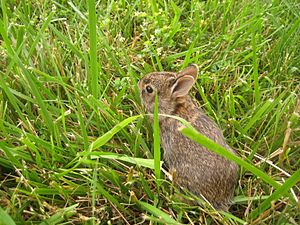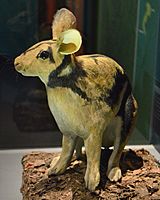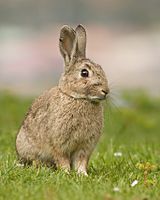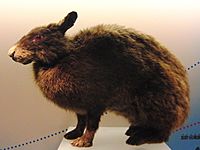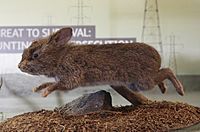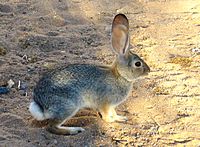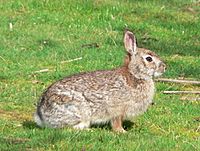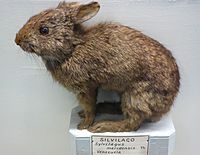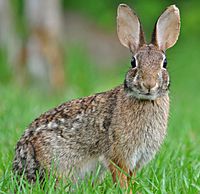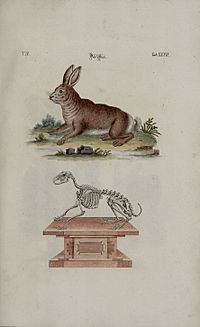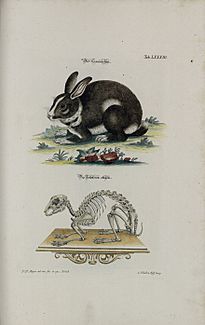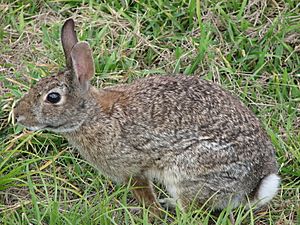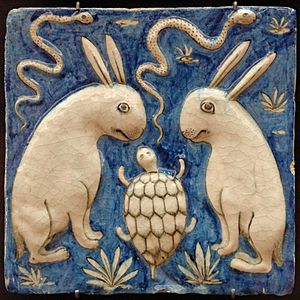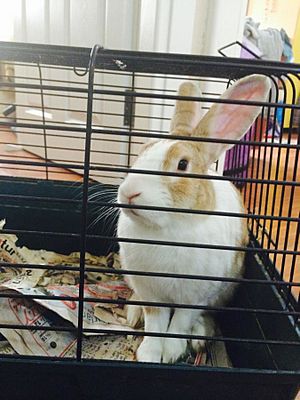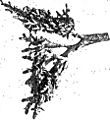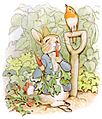Rabbit facts for kids
Quick facts for kids Rabbit |
|
|---|---|
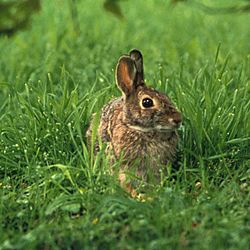 |
|
| Eastern cottontail (Sylvilagus floridanus) | |
| Scientific classification | |
| Kingdom: | |
| Phylum: | |
| Class: | |
| Order: | |
| Family: |
Leporidae
in part |
Rabbits are mammals of the order Lagomorpha. There are about fifty different species of rabbits and hares. The order Lagomorpha is made of rabbits, pikas and hares. Rabbits can be found in many parts of the world. They live in families and eat vegetables and hay. In the wild, rabbits live in burrows, that they dig themselves. A group of rabbits living together in a burrow is called a warren. Rabbits are famous for hopping and eating carrots.
A male rabbit is called a buck, and a female is called a doe. A baby rabbit is called a kit, which is short for kitten. Rabbits have a gestation period of around 31 days. The female can have up to 12-13 kits, very rarely litters as big as 18 and as small as one. Some people have rabbits as pets. Rabbits are also raised for their meat. Rabbits are of a different biological classification than hares.
Since rabbits are prey animals, they are careful in open spaces. If they sense danger, they freeze and watch. Rabbit vision has a very wide field, including overhead scanning. Their enemies are foxes and dogs; also bears, raccoons, minks, weasels and snakes. Birds of prey sometimes take rabbits. People are also known to shoot rabbits, because they eat crops. Their escape method is to run for their burrow, where they are usually safe.
Rabbits have a complex social structure and, like dogs, they have a hierarchy. Rabbit ears probably have several functions. The main function is to give warning of predators, but they may be used for signalling, and temperature regulation.
Contents
Taxonomy
Rabbits and hares were formerly classified in the order Rodentia (rodent) until 1912, when they were moved into a new order, Lagomorpha (which also includes pikas). Below are some of the species of the rabbit.
Differences from hares
Hares are precocial, born relatively mature and mobile with hair and good vision, while rabbits are altricial, born hairless and blind, and requiring closer care. Hares (and cottontail rabbits) live a relatively solitary life in a simple nest above the ground, while most rabbits live in social groups underground in burrows or warrens. Hares are generally larger than rabbits, with ears that are more elongated, and with hind legs that are larger and longer. Hares have not been domesticated, while descendants of the European rabbit are commonly bred as livestock and kept as pets.
Reproduction
The rabbit gestation period is short and ranges from 28 to 36 days with an average period of 31 days. A longer gestation period will generally yield a smaller litter while shorter gestation periods will give birth to a larger litter. The size of a single litter can range from four to 12 kits allowing a female to deliver up to 60 new kits a year. After birth, the female can become pregnant again as early as the next day.
Habitat and range
Rabbit habitats include meadows, woods, forests, grasslands, deserts and wetlands. Rabbits live in groups, and the best known species, the European rabbit, lives in underground burrows, or rabbit holes. A group of burrows is called a warren.
More than half the world's rabbit population resides in North America. They are also native to southwestern Europe, Southeast Asia, Sumatra, some islands of Japan, and in parts of Africa and South America. They are not naturally found in most of Eurasia, where a number of species of hares are present. Rabbits first entered South America relatively recently, as part of the Great American Interchange. Much of the continent has just one species of rabbit, the tapeti, while most of South America's southern cone is without rabbits.
The European rabbit has been introduced to many places around the world.
Environmental problems
Rabbits have been a source of environmental problems when introduced into the wild by humans. As a result of their appetites, and the rate at which they breed, feral rabbit depredation can be problematic for agriculture. Gassing, barriers (fences), shooting, snaring, and ferreting have been used to control rabbit populations, but the most effective measures are diseases such as myxomatosis (myxo or mixi, colloquially) and calicivirus. In Europe, where rabbits are farmed on a large scale, they are protected against myxomatosis and calicivirus with a genetically modified virus. The virus was developed in Spain, and is beneficial to rabbit farmers. If it were to make its way into wild populations in areas such as Australia, it could create a population boom, as those diseases are the most serious threats to rabbit survival. Rabbits in Australia and New Zealand are considered to be such a pest that land owners are legally obliged to control them.
As food and clothing
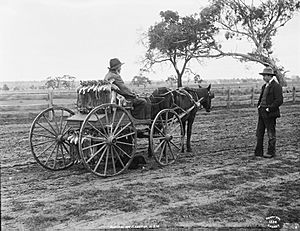
In some areas, wild rabbits and hares are hunted for their meat, a lean source of high quality protein. In the wild, such hunting is accomplished with the aid of trained falcons, ferrets, or dogs, as well as with snares or other traps, and rifles. A caught rabbit may be dispatched with a sharp blow to the back of its head, a practice from which the term rabbit punch is derived.
Wild leporids comprise a small portion of global rabbit-meat consumption. Domesticated descendants of the European rabbit (Oryctolagus cuniculus) that are bred and kept as livestock (a practice called cuniculture) account for the estimated 200 million tons of rabbit meat produced annually. In 1994, the countries with the highest consumption per capita of rabbit meat were Malta with 8.89 kilograms (19.6 lb), Italy with 5.71 kilograms (12.6 lb), and Cyprus with 4.37 kilograms (9.6 lb), falling to 0.03 kilograms (0.066 lb) in Japan. The figure for the United States was 0.14 kilograms (0.31 lb) per capita. The largest producers of rabbit meat in 1994 were China, Russia, Italy, France, and Spain. Rabbit meat was once a common commodity in Sydney, Australia, but declined after the myxomatosis virus was intentionally introduced to control the exploding population of feral rabbits in the area.
In the United Kingdom, fresh rabbit is sold in butcher shops and markets, and some supermarkets sell frozen rabbit meat. At farmers markets there, including the famous Borough Market in London, rabbit carcasses are sometimes displayed hanging, unbutchered (in the traditional style), next to braces of pheasant or other small game. Rabbit meat is a feature of Moroccan cuisine, where it is cooked in a tajine with "raisins and grilled almonds added a few minutes before serving". In China, rabbit meat is particularly popular in Sichuan cuisine, with its stewed rabbit, spicy diced rabbit, BBQ-style rabbit, and even spicy rabbit heads, which have been compared to spicy duck neck. Rabbit meat is comparatively unpopular elsewhere in the Asia-Pacific.
In addition to their meat, rabbits are used for their wool, fur, and pelts, as well as their nitrogen-rich manure and their high-protein milk. Production industries have developed domesticated rabbit breeds (such as the well-known Angora rabbit) to efficiently fill these needs.
In art, literature, and culture
Rabbits are often used as a symbol of fertility or rebirth, and have long been associated with spring and Easter as the Easter Bunny. The species' role as a prey animal with few defenses evokes vulnerability and innocence, and in folklore and modern children's stories, rabbits often appear as sympathetic characters, able to connect easily with youth of all kinds (for example, the Velveteen Rabbit, or Thumper in Bambi).
The rabbit (as a swift prey animal) is also known for its speed, agility, and endurance, symbolized (for example) by the marketing icons the Energizer Bunny and the Duracell Bunny.
Folklore and mythology

"flys with a rabbit's foot talisman,
a gift from a New York girl friend"
The rabbit often appears in folklore as the trickster archetype, as he uses his cunning to outwit his enemies.
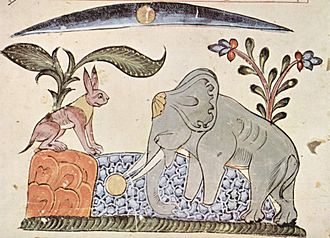
Illustration (from 1354) of the Panchatantra
- In Aztec mythology, a pantheon of four hundred rabbit gods known as Centzon Totochtin, led by Ometotchtli or Two Rabbit, represented fertility, parties, and drunkenness.
- In Central Africa, the common hare (Kalulu), is "inevitably described" as a trickster figure.
- In Chinese folklore, rabbits accompany Chang'e on the Moon. In the Chinese New Year, the zodiacal rabbit is one of the twelve celestial animals in the Chinese zodiac. Note that the Vietnamese zodiac includes a zodiacal cat in place of the rabbit, possibly because rabbits did not inhabit Vietnam. The most common explanation, however, is that the ancient Vietnamese word for "rabbit" (mao) sounds like the Chinese word for "cat" (卯, mao).
- In Japanese tradition, rabbits live on the Moon where they make mochi, the popular snack of mashed sticky rice. This comes from interpreting the pattern of dark patches on the moon as a rabbit standing on tiptoes on the left pounding on an usu, a Japanese mortar.
- In Jewish folklore, rabbits (shfanim שפנים) are associated with cowardice, a usage still current in contemporary Israeli spoken Hebrew (similar to the English colloquial use of "chicken" to denote cowardice).
- In Korean mythology, as in Japanese, rabbits live on the moon making rice cakes ("Tteok" in Korean).
- In Anishinaabe traditional beliefs, held by the Ojibwe and some other Native American peoples, Nanabozho, or Great Rabbit, is an important deity related to the creation of the world.
- A Vietnamese mythological story portrays the rabbit of innocence and youthfulness. The Gods of the myth are shown to be hunting and killing rabbits to show off their power.
- Buddhism, Christianity, and Judaism have associations with an ancient circular motif called the three rabbits (or "three hares"). Its meaning ranges from "peace and tranquility", to purity or the Holy Trinity, to Kabbalistic levels of the soul or to the Jewish diaspora. The tripartite symbol also appears in heraldry and even tattoos.
The rabbit as trickster is a part of American popular culture, as Br'er Rabbit (from African-American folktales and, later, Disney animation) and Bugs Bunny (the cartoon character from Warner Bros.), for example.
Anthropomorphized rabbits have appeared in film and literature, in Alice's Adventures in Wonderland (the White Rabbit and the March Hare characters), in Watership Down (including the film and television adaptations), in Rabbit Hill (by Robert Lawson), and in the Peter Rabbit stories (by Beatrix Potter). In the 1920s, Oswald the Lucky Rabbit, was a popular cartoon character.
Rabbits As Pets
1. Personality
Rabbits can make great pets and tend to bond very closely with their owners. They can be extremely social, and love being around people, making them loyal companions. They also have a tendency to be very independent, which makes caring for them less stressful compared to other pets. Being very social and playful mammals, rabbits are easily distracted by toys. Training a rabbit can be quite easy, using similar techniques as one would to train a dog.
2. Essential Equipment
In order to successfully own a rabbit, there are essential items that are needed. First it is important to have a cage that the rabbit can call home. It does not need to be big, just somewhere that the rabbit can live comfortably and relax. Secondly it is important to have a water bottle or water bowl that is replenished with fresh water daily. A litter box for the corner of the cage is a great purchase because it can help potty-train the rabbit, and can easily be cleaned on either a daily basis or every other day. It is also essential to have toys for a rabbit. Since they are very social and playful animals, it is important for them to have toys to play with while their owners are not able to be with them.
After purchasing essential housing items for a rabbit, a new owner needs to purchase bedding for the cage. Having newspaper handy makes cleaning the cage extremely easy and (hopefully) a little less messy.
3. Grooming
Grooming a rabbit is essential for their health and wellbeing. Purchasing a brush at a local pet shop comes in handy when grooming. It is important to groom a rabbit on a weekly basis because they tend to groom themselves obsessively, but it becomes dangerous to their health due to the fact that they swallow so much of their fur.
4. Feeding
Rabbits are extremely easy pets to feed. It is important to make sure that they are being fed fresh hay and grains on a daily basis. Providing a rabbit with fresh, well-washed vegetables every day is essential for a balanced diet and digestion. Fruits can be given to rabbits every once in a while as a snack, but it is important to keep a rabbits’ fruit intake limited due to all of the sugars.
5. Exercise
In order for rabbits to live happy and healthy lives, it is important for them to get out of their cages and exercise on a daily basis. Hopping around the house for a couple of hours a day will allow a rabbit to explore its surroundings and stay healthy.
6. Safety
Bunny-proofing a rabbit owners’ home is vital. These curious critters tend to be drawn towards electrical wires, wood, shoes, furniture – basically everything within a normal household. It is important to be present when a rabbit is venturing outside of its cage to ensure its safety, or have an area for it to hop around in that does not have any dangerous items.
Wild rabbits
Wild rabbits are nomaly called hares, but you can get wild rabbits.
Images for kids
See also
 In Spanish: Oryctolagus cuniculus para niños
In Spanish: Oryctolagus cuniculus para niños


